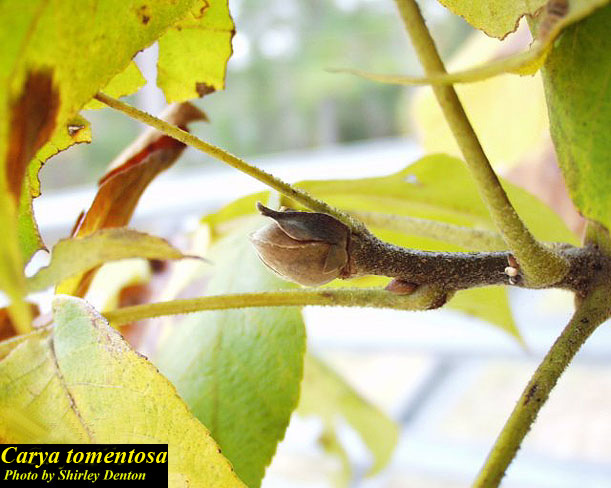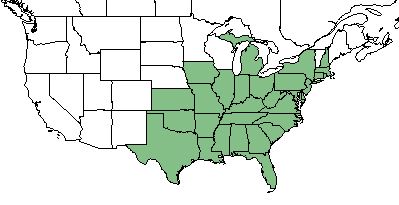Difference between revisions of "Carya tomentosa"
(→Ecology) |
|||
| Line 31: | Line 31: | ||
==Ecology== | ==Ecology== | ||
===Habitat=== <!--Natural communities, human disturbed habitats, topography, hydrology, soils, light, fire regime requirements for removal of competition, etc.--> | ===Habitat=== <!--Natural communities, human disturbed habitats, topography, hydrology, soils, light, fire regime requirements for removal of competition, etc.--> | ||
| − | ''C. tomentosa'' can be found in communities ranging from mesic hammocks to pine sandhills <ref name= "Heuberger"> Heuberger, K. A. and F. E. Putz (2003). "Fire in the suburbs: ecological impacts of prescribed fire in small remnants of longleaf pine (Pinus palustris) sandhill." Restoration Ecology 11: 72-81. </ref>. | + | ''C. tomentosa'' can be found in communities ranging from mesic hammocks to pine sandhills <ref name= "Heuberger"> Heuberger, K. A. and F. E. Putz (2003). "Fire in the suburbs: ecological impacts of prescribed fire in small remnants of longleaf pine (Pinus palustris) sandhill." Restoration Ecology 11: 72-81. </ref>. More specifically, the habitats range from mixed hardwood forests, disturbed meadows, in sandy soil of mesic woods, rich deciduous woods, hardwood hammocks, wooded ravines, and loamy sand woodlands. <ref name= "Herbarium"> Florida State University Robert K. Godfrey Herbarium database. URL: http://herbarium.bio.fsu.edu. Last accessed: June 2018. Collectors: Cecil R. Slaughter, Travis MacClendon, Karen MacClendon, Cindi Stewart, Loran C. Anderson, R. K. Godfrey, Gwynn W. Ramsey, R. S. Mitchell, Donald E. Stone, R. Kral, Victoria I. Sullivan, Patricia Elliott, H. Kurz, and Palmer Kinser. States and counties: Florida: Nassau, Washington, Leon, Wakulla, Jackson, Liberty, Suwannee, Gadsden, Calhoun, and Alachua. </ref> |
Associated species: ''Pinus palustris'', ''Quercus hemisphaerica'', ''Quercus incana'', ''Quercus falcata'', ''Quercus virginiana'', and ''Quercus laevis'' <ref name= "Heuberger"/>. | Associated species: ''Pinus palustris'', ''Quercus hemisphaerica'', ''Quercus incana'', ''Quercus falcata'', ''Quercus virginiana'', and ''Quercus laevis'' <ref name= "Heuberger"/>. | ||
| − | + | ===Phenology=== <!--Timing off flowering, fruiting, seed dispersal, and environmental triggers. Cite PanFlora website if appropriate: http://www.gilnelson.com/PanFlora/ --> | |
| + | Fruit has been seen to be present from March to May and July as well as the month of October. <ref name= "Herbarium"/> | ||
| + | |||
===Seed dispersal=== | ===Seed dispersal=== | ||
''C. tomentosa'' is dispersed through various mammals found in the pine sandhills community <ref name= "Myster"> Myster, R. W. and S. T. A. Pickett (1993). "Effects of litter, distance, density and vegetation patch type on post dispersal tree seed predation in old fields." Oikos 66: 381-388. </ref>. | ''C. tomentosa'' is dispersed through various mammals found in the pine sandhills community <ref name= "Myster"> Myster, R. W. and S. T. A. Pickett (1993). "Effects of litter, distance, density and vegetation patch type on post dispersal tree seed predation in old fields." Oikos 66: 381-388. </ref>. | ||
Revision as of 19:04, 12 June 2018
| Carya tomentosa | |
|---|---|

| |
| Photo by the Atlas of Florida Plants Database | |
| Scientific classification | |
| Kingdom: | Plantae |
| Division: | Magnoliophyta - Flowering plants |
| Class: | Magnoliopsida - Dicots |
| Order: | Juglandales |
| Family: | Juglandaceae |
| Genus: | Carya |
| Species: | C. tomentosa |
| Binomial name | |
| Carya tomentosa Lam. | |

| |
| Natural range of Carya tomentosa from USDA NRCS Plants Database. | |
Contents
Taxonomic Notes
Synonyms: Carya alba (L.) Nuttall ex Elliott, Hicoria alba (L.) Britton
Varieties: none
Description
C. tomentosa, also known as mockernut hickory, is a native perennial in the Juglandaceae family with a tree growth habit [1].
Distribution
The species can be found throughout most of Eastern United States, ranging from Texas and Kansas to New Hampshire and Michigan [1].
Ecology
Habitat
C. tomentosa can be found in communities ranging from mesic hammocks to pine sandhills [2]. More specifically, the habitats range from mixed hardwood forests, disturbed meadows, in sandy soil of mesic woods, rich deciduous woods, hardwood hammocks, wooded ravines, and loamy sand woodlands. [3]
Associated species: Pinus palustris, Quercus hemisphaerica, Quercus incana, Quercus falcata, Quercus virginiana, and Quercus laevis [2].
Phenology
Fruit has been seen to be present from March to May and July as well as the month of October. [3]
Seed dispersal
C. tomentosa is dispersed through various mammals found in the pine sandhills community [4].
Conservation and Management
Cultivation and restoration
Photo Gallery
References and notes
- ↑ 1.0 1.1 USDA Plants Database URL: https://plants.usda.gov/core/profile?symbol=CATO6
- ↑ 2.0 2.1 Heuberger, K. A. and F. E. Putz (2003). "Fire in the suburbs: ecological impacts of prescribed fire in small remnants of longleaf pine (Pinus palustris) sandhill." Restoration Ecology 11: 72-81.
- ↑ 3.0 3.1 Florida State University Robert K. Godfrey Herbarium database. URL: http://herbarium.bio.fsu.edu. Last accessed: June 2018. Collectors: Cecil R. Slaughter, Travis MacClendon, Karen MacClendon, Cindi Stewart, Loran C. Anderson, R. K. Godfrey, Gwynn W. Ramsey, R. S. Mitchell, Donald E. Stone, R. Kral, Victoria I. Sullivan, Patricia Elliott, H. Kurz, and Palmer Kinser. States and counties: Florida: Nassau, Washington, Leon, Wakulla, Jackson, Liberty, Suwannee, Gadsden, Calhoun, and Alachua.
- ↑ Myster, R. W. and S. T. A. Pickett (1993). "Effects of litter, distance, density and vegetation patch type on post dispersal tree seed predation in old fields." Oikos 66: 381-388.